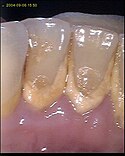Zubní kámen
Zubní kámen se tvoří ze zubního plaku, na kterém se ukládají minerální látky ze slin a zbytků potravin. Původně měkký a snadno odstranitelný povlak již nelze odstranit za pomoci zubní pasty a kartáčku. Ze zubního kamene se uvolňují látky, které jsou pro dásně dráždivé a agresivní. Dásně jsou posléze zčervenalé, oteklé, a když jsou zanícené, vzniká tzv. zánět dásní. Zubní kámen nikdy nezpůsobuje bolest, ale je příčinou vzniku zánětu dásní a ten již bolest způsobuje.
Odstranění zubního kamene
Existují zubní pasty, které jsou speciálně určené proti vzniku zubního kamene. Ty ale působí skutečně jen proti jeho vzniku. Již existující zubní kámen nelze odstranit jakoukoli volně prodejnou zubní pastou.
Zubní kámen se odstraňuje buď ultrazvukem nebo mechanicky ručními nástroji a pastou v přibližně ročním intervalu. Tento zákrok provádí zubní lékař nebo také zubní hygienista, specialista na prevenci problémů s chrupem. Zákrok se nazývá kyretáž (deep scaling), ale jeho účinnost, jako prevence zubního kazu, je ale (např. organizací Cochrane Collaboration) zpochybňována (navíc může vést k poškozování zubů).[1]
Reference
- ↑ WORTHINGTON, Helen V; CLARKSON, Jan E; BRYAN, Gemma; BEIRNE, Paul V. Routine scale and polish for periodontal health in adults. Cochrane Database of Systematic Reviews [online]. 2013-11-07. Dostupné online. DOI 10.1002/14651858.CD004625.pub4. (anglicky)
Externí odkazy
 Obrázky, zvuky či videa k tématu zubní kámen na Wikimedia Commons
Obrázky, zvuky či videa k tématu zubní kámen na Wikimedia Commons  Encyklopedické heslo Kámen v Ottově slovníku naučném ve Wikizdrojích
Encyklopedické heslo Kámen v Ottově slovníku naučném ve Wikizdrojích
Přečtěte si prosím pokyny pro využití článků o zdravotnictví.
Média použitá na této stránce
Star of life, blue version. Represents the Rod of Asclepius, with a snake around it, on a 6-branch star shaped as the cross of 3 thick 3:1 rectangles.
Design:
The logo is basically unicolor, most often a slate or medium blue, but this design uses a slightly lighter shade of blue for the outer outline of the cross, and the outlines of the rod and of the snake. The background is transparent (but the star includes a small inner plain white outline). This makes this image usable and visible on any background, including blue. The light shade of color for the outlines makes the form more visible at smaller resolutions, so that the image can easily be used as an icon.
This SVG file was manually created to specify alignments, to use only integers at the core 192x192 size, to get smooth curves on connection points (without any angle), to make a perfect logo centered in a exact square, to use a more precise geometry for the star and to use slate blue color with slightly lighter outlines on the cross, the rod and snake.
Finally, the SVG file is clean and contains no unnecessary XML elements or attributes, CSS styles or transforms that are usually added silently by common SVG editors (like Sodipodi or Inkscape) and that just pollute the final document, so it just needs the core SVG elements for the rendering. This is why its file size is so small.Autor: No machine-readable author provided. Dozenist assumed (based on copyright claims)., Licence: CC BY-SA 3.0
Photograph taken of patient, who will remain anonymous, treated at the University of Tennessee Health Science Center: College of Dentistry in Memphis, Tennessee. The mandibular tori on this patient is larger than normal, and a great example of this anatomic structure Source: Photo taken by Dozenist




